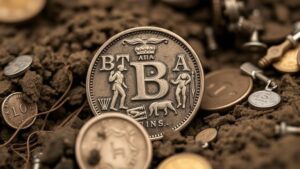Unearthing Gold Coins in Deserted Canyon Floor Settlements
Unearthing Gold Coins in Deserted Canyon Floor Settlements
The discovery of gold coins in abandoned canyon floor settlements is a fascinating intersection of archaeology, economics, and history. These settlements, often situated in remote and rugged terrains, offer unique insights into past civilizations and their economic practices. This article delves into the methodologies used in locating these treasures, the historical context behind such settlements, and the modern implications of these findings.
Historical Context of Canyon Floor Settlements
Deserted canyon settlements are often remnants of societies that thrived in arid conditions. In the United States, for example, many of these settlements are associated with the mining boom of the late 19th century. The allure of precious metals like gold prompted entire communities to flourish in seemingly inhospitable environments. But, as resources became scarce or mining technologies evolved, many of these settlements were abandoned.
Consider the case of Bodie, California, a gold-mining town that experienced rapid growth in the late 1800s. At its peak, Bodie housed over 10,000 residents. Once the mines were depleted, the town was largely deserted, leaving behind a rich tapestry of artifacts that now serve as a glimpse into a bygone era.
Methodologies for Unearthing Gold Coins
Uncovering gold coins in these deserted settlements typically involves various archaeological and metal-detecting methodologies. following approaches are commonly utilized:
- Ground Penetrating Radar (GPR): This non-invasive technique allows archaeologists to visualize the subsurface structures without disturbing the ground. GPR can identify potential areas of interest, such as old foundations or burial sites, where coins might be located.
- Metal Detectors: These devices have revolutionized treasure hunting, especially in sites rich in mineralization. Modern metal detectors can differentiate between precious metals and other materials, thus enhancing the chances of finding gold coins.
- Excavation: Once potential areas are identified, careful excavation often follows, employing tools ranging from trowels to larger machinery. goal is to preserve the historical context while retrieving artifacts.
Case Studies and Notable Discoveries
Numerous case studies highlight the successful discovery of gold coins in abandoned canyon settlements. One significant example is the discovery of a hoard of gold coins in the Lost Dutchman Mine area in Arizona. Although the mines location is shrouded in legend and mystery, the site has attracted many treasure hunters, some of whom uncovered coins dating back to Spanish colonial times. e findings have not only monetary value but also historical significance, offering deeper insights into trade routes and economic practices of early settlers.
Similarly, in the Grand Canyon region, several expeditions have unearthed gold coins from the late 1800s. These coins, often marked with specific mint marks, provide clues about the flow of currency during that era and the socio-economic conditions that existed in remote settlements.
Economic Implications of Discoveries
The unearthing of gold coins carries significant economic implications, both for local communities and scholars. From an economic standpoint, the revival of interest in these settlements can lead to:
- Tourism: Successful discoveries often result in increased tourist activity, as people flock to explore historical sites. Local economies can benefit significantly from such influxes.
- Research Funding: The significance of these findings may attract academic and private funding, fostering more extensive archaeological research and preservation efforts.
Preservation and Ethical Considerations
As with any archaeological endeavor, ethical considerations must be taken into account when unearthing artifacts. Its essential to ensure that finds are documented accurately and preserved for future generations. Issues surrounding ownership, cultural heritage, and the environmental impact of excavation are pivotal in guiding these efforts. Engaging with local communities and adhering to archaeological protocols helps mitigate potential conflicts and fosters a sense of shared heritage.
Actionable Takeaways
For those interested in pursuing treasure hunting, archaeology, or preserving historical artifacts, consider the following actionable takeaways:
- Always research the legalities involved in treasure hunting within your desired area, including permits and ownership laws.
- Use proper equipment and techniques to minimize damage to archaeological sites when conducting independent searches.
- Engage with local historical societies to contribute to preservation efforts and gain insights from seasoned historians.
To wrap up, the unearthing of gold coins in deserted canyon floor settlements is a multi-faceted endeavor that encompasses archaeology, history, and economic considerations. By employing advanced methodologies and adhering to ethical practices, we can continue to reveal the rich narratives embedded in these historical sites while fostering a deeper understanding of past civilizations.


